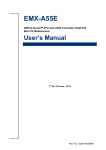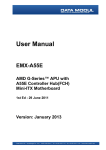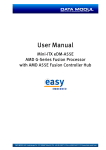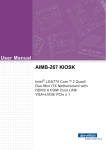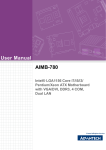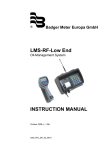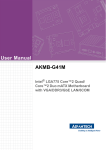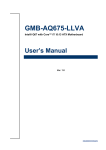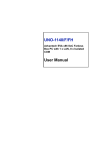Download Advantech SIMB-M22 User manual
Transcript
User Manual SIMB-M22 AMD G-Series APU with A55E Controller Hub (FCH) Mini-ITX Motherboard Safety Information Electrical safety To prevent electrical shock hazard, disconnect the power cable from the electrical outlet before relocating the system. When adding or removing devices to or from the system, ensure that the power cables for the devices are unplugged before the signal cables are connected. If possible, disconnect all power cables from the existing system before you add a device. Before connecting or removing signal cables from the motherboard, ensure that all power cables are unplugged. Seek professional assistance before using an adapter or extension cord. These devices could interrupt the grounding circuit. Make sure that your power supply is set to the correct voltage in your area. If you are not sure about the voltage of the electrical outlet you are using, contact your local power company. If the power supply is broken, do not try to fix it by yourself. Contact a qualified service technician or your retailer. Operation safety Before installing the motherboard and adding devices on it, carefully read all the manuals that came with the package. Before using the product, make sure all cables are correctly connected and the power cables are not damaged. If you detect any damage, contact your dealer immediately. To avoid short circuits, keep paper clips, screws, and staples away from connectors, slots, sockets and circuitry. Avoid dust, humidity, and temperature extremes. Do not place the product in any area where it may become wet. Place the product on a stable surface. If you encounter technical problems with the product, contact a qualified service technician or your retailer. The symbol of the crossed out wheeled bin indicates that the product (electrical and electronic equipment) should not be placed in municipal waste. Check local regulations for disposal of electronic products. SIMB-M22 User Manual Part No. 20060M2200 Edition 1 Printed in China September 2011 ii Technical Support If a problem arises with your system and no solution can be obtained from the user’s manual, please contact your place of purchase or local distributor. Alternatively, please try the following help resources for further guidance. Visit the Advantech website for FAQ, technical guide, BIOS updates, driver updates, and other information: http://support.advantech.com/support/default.aspx Conventions Used in This Guide To make sure that you perform certain tasks properly, take note of the following symbols used throughout this manual. Warning! Information to prevent injury to yourself when trying to complete a task. Caution! CAUTION: Information to prevent damage to the components when trying to complete a task. Important! Instructions that you MUST follow to complete a task. Note! Tips and additional information to help you complete a task. Packing List Before you begin installing your single board, please make sure that the following materials have been shipped: 1 x SIMB-M22 Mini ITX Main board 1 x CD-ROM per carton, which contains the followings: – User’s Manual – Drivers 1 x SATA cable kit (SATA/POWER) 1 x I/O Shield 1 x Startup Manual per carton If any of the above items is damaged or missing, please contact your retailer. iii SIMB-M22 User Manual SIMB-M22 User Manual iv Contents Chapter 1 Product Overview ................................1 1.1 Specifications Summary............................................................................ 2 1.1.1 System .......................................................................................... 2 1.1.2 Memory ......................................................................................... 2 1.1.3 Chipset.......................................................................................... 2 1.1.4 BIOS ............................................................................................. 4 1.1.5 Internal Connector ........................................................................ 4 1.1.6 Front I/O........................................................................................ 5 1.1.7 Power............................................................................................ 6 1.1.8 LED Indicator ................................................................................ 6 1.1.9 Expansion Slot .............................................................................. 6 1.1.10 Accessory ..................................................................................... 7 Block Diagram........................................................................................... 7 Figure 1.1 Block Diagram ............................................................ 7 1.2 Chapter 2 Product Introduction ...........................9 2.1 2.2 Before you proceed................................................................................. 10 Motherboard overview............................................................................. 10 2.2.1 Placement Direction.................................................................... 10 2.2.2 Screw Holes................................................................................ 11 Motherboard Layout ................................................................................ 12 Figure 2.1 Board Layout ............................................................ 12 Table 2.1: Slots.......................................................................... 12 Table 2.2: Jumpers.................................................................... 12 Table 2.3: Rear IO ..................................................................... 13 Central Processing Unit (CPU) ............................................................... 13 2.4.1 Connect the CPU Fan cable to the CPU_FAN connector on the motherboard................................................................................ 13 2.4.2 Connect the CPU Fan Cable ...................................................... 14 System Memory ...................................................................................... 15 2.5.1 DIMM Sockets Location .............................................................. 15 2.5.2 Memory Configurations............................................................... 15 2.5.3 Installing a DDR3 DIMM ............................................................. 16 2.5.4 Removing a DDR3 DIMM ........................................................... 17 Expansion Slots ...................................................................................... 17 2.6.1 Installing an Expansion Card ...................................................... 17 2.6.2 Configuring an Expansion Card .................................................. 18 2.6.3 Standard Interrupt Assignments ................................................. 18 Jumpers .................................................................................................. 18 2.7.1 Clear CMOS (CMOS1) ............................................................... 18 2.7.2 COM3 RI/+5V/+12V Selection (JSETCOM3).............................. 19 2.7.3 COM4 RI/+5V/+12V Selection (JSETCOM4).............................. 20 Connectors.............................................................................................. 20 2.8.1 Rear Panel Connectors............................................................... 20 Figure 2.2 Rear Panel Connectors ............................................ 20 2.8.2 Front Panel Audio Connector (AAFP)......................................... 22 2.8.3 ATX Power Connector (ATXPWR) ............................................. 22 2.8.4 AT/ATX Mode Select (PSON1)................................................... 23 2.8.5 LCD POWER (VDDSAFE) (JBL3) .............................................. 23 2.8.6 Serial Port Connector (COM3, COM4) ....................................... 24 2.8.7 System Panel & Speaker (JFP1 + JFP2).................................... 24 2.8.8 Power LED & Keylock (JFP3) ..................................................... 25 2.8.9 Inverter PWR (JBL1)................................................................... 25 2.3 2.4 2.5 2.6 2.7 2.8 v SIMB-M22 User Manual 2.8.10 2.8.11 2.8.12 2.8.13 2.8.14 2.8.15 Chapter SPI connector (CN4)................................................................... 26 SPDIF OUT (SPDIF_OUT1) ....................................................... 26 18-bit LVDS Connector (LVDS1) ................................................ 27 AMP_R+R-/AMP_L+L- (CN10)................................................... 27 Serial ATA Connector (SATA1, SATA2)..................................... 28 USB 2.0 Connector (USB56) ...................................................... 29 3 BIOS Setup ........................................ 31 3.1 BIOS Setup Program .............................................................................. 32 3.1.1 Legend Box................................................................................. 32 3.1.2 List Box ....................................................................................... 33 3.1.3 Sub-menu ................................................................................... 33 BIOS Menu Screen ................................................................................. 33 3.2.1 BIOS Menu Screen..................................................................... 34 3.2.2 Advanced.................................................................................... 34 3.2.3 Chipset........................................................................................ 41 3.2.4 Boot ............................................................................................ 46 3.2.5 Save & Exit ................................................................................. 47 3.2 SIMB-M22 User Manual vi Chapter 1 Product Overview 1 1.1 Specifications Summary 1.1.1 System APU G-Series APU Type AMD G-Series T40R 1.0GHz SC Processor Family AMD G-Series Long Life Processor List TDP 5.5W, T shutdown 125° C Package FT1 (BGA) 413 balls p=0.8mm, 19x19 mm L2 Cache L1: 32KB+32KB per core, L2: 512KB cache per core UMI 4-Lane (x4) PCIe gen2 Power Management C6 supported PCIE 4-Lane(x4) PCIe gen2 CPU Process 40 nm 1.1.2 Memory System Memory Memory Type One DDR3 1066/1333 SODIMM DIMM # 1x SODIMM 204-Pin/ Single Channel Max. Capacity 4 GB 1.1.3 Chipset FCH Fusion Controller Hub AMD A55E Controller Hub (Hudson-E1) PCIe x4 Gen 2 USB 8 USB 2.0 (4 Rear, 4 Internal) SMBus Yes LPC Yes SATA 5 SATA 3.0 (One support SATA DOM) HD Audio support 4 channel, Power Saving, 4 codec Clock Gen. Integrated Package FCBGA 23x23mm, 605 balls Environment TDP 2.7 ~ 5.7 W, T case 105° C Display Integrated Graphic Controller AMD Radeon HD 6250 HW decoder/3D feature DirectX 11, OpenGL4.0, dedicated HW(UVD3.0)for H.264, VC-1, MPEG-2, DivX decode LVDS 1, 18bpp (Single link LVDS up to 1400 x 1050) VGA 1, supports up to 1920 x 1200 HDMI 1,support HDMI 1.3a & 1080p up to 1920 x 1080 Dual Display VGA+LVDS, VGA+HDMI, HDMI+LVDS SIMB-M22 User Manual 2 Chipset LAN1 RTL 8111DL Gigabit LAN LAN2 RTL 8111DL Gigabit LAN Left: Link (Off)/ Active (Flash Yellow) Right: 1Gbps(Green) / 100Mbps (Orange) / 10Mbps (Off) Disable LAN through BIOS Yes WOL Yes Boot from LAN Yes ASF N/A Audio Codec 7.1 Channel HD Audio Chipset Realtek ALC892 Audio output header Yes, Front Audio Pin Header Front IO Connector Stack Phone Jack (Mic In, Line-out, Line-in) SPDI/F Yes Amplifier TI TPA3005 RS232 COM LPC to COM 2 COM for Rear I/O D-Sub 2 COM with headers Super I/O Chipset Winbond W83627DHG-P Fan speed monitor & control FAN Speed Control by Thermal Sensor Temperature Yes Voltage +3.3V, +5V, 5Vsb, +12V, -12V Buzzer Onboard buzzer Yes WDT Watchdog Timer Programmable 1~255 sec/min TPM TPM N/A 3 SIMB-M22 User Manual Product Overview LAN LED Chapter 1 Gigabit Ethernet 1.1.4 BIOS BIOS Core BIOS Core AMI EFI BIOS Flash BIOS Flash 16Mb SPI SW RAID SW RAID None Bootup Device Serial ATA Yes IDE device N/A USB device Yes Boot from LAN Yes Power Management ACPI ACPI 3.0 APM NA Sleep State S3, S4, S5 Other Features PC Health YES CMOS backup BIOS CMOS automatic backup and restore setup data SmartFAN CPU, SYS FAN, Smart Fan III+ Graphics memory mode Shared Memory up to 2GB Power Play 380, 200MHz, configure Power to 2.7 ~ 5.7 W SATA Support SATA III (6Gbps) 1.1.5 Internal Connector Debug Port CPU HDT header SPI 1 Display LVDS 1 eDP 1, (optional) Inverter LVDS INV 1, 3.3 V Audio Front Panel 1 Amplifier 1 SPDI/F 1 SIMB-M22 User Manual 4 Chapter 1 USB USB 4 Serial COM 2 IDE NA SATA SATA 5 (SATA III 6 Gb/s) SATA power NA Fan connector System fan connector 1 system fan(3pin for system with smart fan control) CPU fan connector 1 CPU fan(3pin for system with smart fan control) GPIO General 8bit 1.1.6 Front I/O Display HDMI 1 VGA 1, co-layout with header DVI NA Ethernet RJ-45 2, stack with USB USB USB 4 (USB 2.0 port) COM Serial port 2 RS-232 PS/2 KB/MS 2, co-lay single DIN Audio 1 Line-in Phone Jack 1 Line-out 1 MIC co-lay 1 jack connector 5 SIMB-M22 User Manual Product Overview IDE 1.1.7 Power Power Connector Power Type AT/ATX Power Requirement +3.3V, +5V, +12V, -12V, 5Vsb 1.1.8 LED Indicator LED HDD Status Power on rear IO 4; alive, green; dead, red 4; access, flash yellow 1; Blue 1.1.9 Expansion Slot Expansion Slot Mini-PCI Express 1 PCIe x4 1 1.1.10 Mechanical & Environmental PCB Physical Feature Dimension 170 x 170mm Layer 6 Layer Power Consumption < 45W Operating Temperature 0° C ~ 50° C Heat Sink Cooler FAN Storage Temperature -20° C ~ 70° C Vibration (non OP) 3.0 Grms, heat sink backplane TBD PCB Printing Model name in silkscreen None Revision in silkscreen No PCB Color Green CE mark on PCB Yes WEEE Yes Advantech PCB part number Yes Version No FCC mark on PCB Yes Cert. Compliance CE Pre-scan for Class B, EN-55022/24 FCC Pre-scan for FCC PART 15, Class B IEC-60601 compliance SIMB-M22 User Manual 6 Chapter 1 1.1.11 Accessory Accessory List FP_USB cable None SATA cable Kit 1 data and 1 power I/O Shield 1 1 per 20 units Startup Manual 1 per 20 units FP_Power button, power LED, HDD LED kit None AVL OS Support List Windows XP SP3, Windows 7 Pro, Linux Fedora 14 1.2 Block Diagram AMD G-Series D-Sub 18-bit LVDS RGB SC/5.5W T40R 1.0 GHz LTDP0 Channel A DDR3 1066MHz Gen 2 PCIe x4 PCIe x4 Slot eDP (optional) HDMI 1.3a HDT Pin Header (Debug) TMDS (LTDP1) UMI Audio AMP TPA3005 HD Audio Mini Card Connector USB 2.0 8 x USB 2.0 ports USB 2.0 SPI ROM SPI PCIe x1 AMD A55E PCIe x1 LAN 1 Realtek RTL8111DL PCIe x1 LAN 2 Realtek RTL8111DL 6Gb/s SATA 3.0 5 x SATA 3.0 ports LPC Realtek ALC892 Fintek 81216AD Winbond 83627DHG-P 2 x RS-232 ports 2 x RS-232 ports, 2 x PS/2 KB/MS, H/W Monitor, 8-bit GPIO Figure 1.1 Block Diagram 7 SIMB-M22 User Manual Product Overview Driver CD SIMB-M22 User Manual 8 Chapter 2 2 Product Introduction This chapter describes the main board features and the new technologies it supports. 2.1 Before you proceed Take note of the following precautions before you install motherboard components or change any motherboard settings. Caution! Unplug the power cord from the wall socket before touching any component. Use a grounded wrist strap or touch a safely grounded object or a metal object, such as the power supply case, before handling components to avoid damaging them due to static electricity Hold components by the edges to avoid touching the ICs on them. Whenever you uninstall any component, place it on a grounded anti-static pad or in the bag that came with the component. Before you install or remove any component, ensure that the ATX power supply is switched off or the power cord is detached from the power supply. Failure to do so may cause severe damage to the motherboard, peripherals, and/or components. 2.2 Motherboard overview Before you install the motherboard, study the configuration of your chassis to ensure that the motherboard fits into it. Warning! Make sure to unplug the power cord before installing or removing the motherboard. Failure to do so can cause you physical injury and damage motherboard components. 2.2.1 Placement Direction When installing the motherboard, make sure that you place it into the chassis in the correct orientation. The edge with external ports goes to the rear part of the chassis as indicated in the image below. SIMB-M22 User Manual 10 Place four (4) screws into the holes indicated by circles to secure the motherboard to the chassis. Warning! Do not over tighten the screws! Doing so can damage the motherboard. 11 SIMB-M22 User Manual Product Introduction Place this side towards the rear of the chassis. Chapter 2 2.2.2 Screw Holes 2.3 Motherboard Layout Figure 2.1 Board Layout Layout Content List Table 2.1: Slots Label Function Note MINI_PCIE Mini PCIe slot 52PIN PCIE PCIe slot 64PIN SODIMM_A1 204-PIN SODIMM slot 1 204-PIN Table 2.2: Jumpers Label Function Note CLRTC Clear CMOS 3 x 1 header, pitch 2.54mm JCOMPWR1 COM1 RI/+5V/+12V Selection 3 x 2 header, pitch 2.0mm JCOMPWR2 COM2 RI/+5V/+12V Selection 3 x 2 header, pitch 2.0mm SIMB-M22 User Manual 12 Label Function Note PS/2 keyboard and mouse 6-pin Mini-Din COM12 Serial Port Connector D-sub 9-pin, male VGA_DVI VGA Connector D-sub 15-pin, female USB3,4,5,6 USB Connector x 4 2 x 5 Header, pitch 2.54mm LAN1,2 RJ-45 Ethernet Connector x 2 AUDIO Line-in Port, Line-out Port, Microphone Port, 7.1 Channel Audio I/O (3 jacks) 2.4 Central Processing Unit (CPU) 2.4.1 Connect the CPU Fan cable to the CPU_FAN connector on the motherboard. Important! Do not forget to connect the CPU Fan connector! Hardware monitoring errors can occur if you fail to plug this connector. Warning! After installation, make sure to plug-in the ATX power cable to the motherboard. 13 SIMB-M22 User Manual Product Introduction KBMS Chapter 2 Table 2.3: Rear IO 2.4.2 Connect the CPU Fan Cable Connect the CPU fan cable to the CPU_FAN connector on the motherboard. Caution! Do not forget to connect the fan cables to the fan connectors. Insufficient air flow inside the system may damage the motherboard components, and hardware monitoring errors can occur if you fail to plug this connector. These are not jumpers! DO NOT place jumper caps on the fan connectors. Warning! After installation, make sure to plug-in the ATX power cable to the motherboard. SIMB-M22 User Manual 14 2.5.1 DIMM Sockets Location The motherboard comes with one 204-pin Double Data Rate 3 (DDR3) SODIMM sockets. A DDR3 module has the same physical dimensions as a DDR DIMM but has a 204pin footprint. DDR3 DIMMs are notched differently to prevent installation on a DDR DIMM socket. The following figure illustrates the location of the sockets: Chapter 2 2.5 System Memory Product Introduction 2.5.2 Memory Configurations You can install 1GB, 2GB and 4GB DDR3 DIMMs into the SODIMM sockets using the memory configurations in this section. Important! Installing DDR3 DIMM other than the recommended configurations may cause memory sizing error or system boot failure. Use any of the recommended configurations. Always install DIMMs with the same CAS latency. For optimum compatibility, it is recommended that you obtain memory modules from the same vendor. This motherboard does not support memory modules made up of 128 Mb chips or double-sided x16 memory modules. Make sure that the memory frequency matches the CPU FSB (Front Side Bus). Refer to the Memory frequency/CPU FSB synchronization table. 15 SIMB-M22 User Manual 2.5.3 Installing a DDR3 DIMM Caution! Make sure to unplug the power supply before adding or removing DIMMs or other system components. Failure to do so may cause severe damage to both the motherboard and the components. 1. 2. 3. 4. Locate the DIMM socket on the board. Hold two edges of the DIMM module carefully, and keep away of touching its connectors. Align the notch key on the module with the rib on the slot. Firmly press the modules into the socket automatically snaps into the mounting notch. Do not force the DIMM module in with extra force as the DIMM module only fit in one direction. Caution! SIMB-M22 User Manual A DDR3 DIMM is keyed with a notch so that it fits in only one direction. DO NOT force a DIMM into a socket to avoid damaging the DIMM. The DDR3 DIMM sockets do not support DDR DIMMs. DO NOT install DDR DIMMs to the DDR3 DIMM socket. 16 Press the two ejector tabs on the slot outward simultaneously, and then pull out the DIMM module. 2.6 Expansion Slots In the future, you may need to install expansion cards. The following sub-sections describe the slots and the expansion cards that they support. Warning! Make sure to unplug the power cord before adding or removing expansion cards. Failure to do so may cause you physical injury and damage motherboard components. 2.6.1 Installing an Expansion Card 1. 2. 3. 4. 5. 6. Before installing the expansion card, read the documentation that came with it and make the necessary hardware settings for the card. Remove the system unit cover (if your motherboard is already installed in a chassis). Remove the bracket opposite the slot that you intend to use. Keep the screw for later use. Align the card connector with the slot and press firmly until the card is completely seated on the slot. Secure the card to the chassis with the screw you removed earlier. Replace the system cover. 17 SIMB-M22 User Manual Product Introduction Caution! Support the DIMM lightly with your fingers when pressing the ejector tabs. The DIMM might get damaged when it flips out with extra force. Chapter 2 2.5.4 Removing a DDR3 DIMM 2.6.2 Configuring an Expansion Card After installing the expansion card, configure it by adjusting the software settings. 1. Turn on the system and change the necessary BIOS settings if any. 2. Assign an IRQ to the card if needed. Refer to the tables on the next page. 3. Install the software drivers for the expansion card. 2.6.3 Standard Interrupt Assignments IRQ Priority Standard Function 0 1 System Timer 1 2 Keyboard Controller 2 - Redirect to IRQ#9 3 11 IRQ holder for PCI steering* 4 12 Communications Port (COM1)* 5 13 IRQ holder for PCI steering* 6 14 Floppy Disk Controller 7 15 Printer Port (LPT)* 8 3 System CMOS/Rear Time 9 4 IRQ holder for PCI steering* 10 5 IRQ holder for PCI steering* 11 6 IRQ holder for PCI steering* 12 7 PS/2 Compatible Mouse Port* 13 8 Numeric Data Processor 14 9 Primary IDE Channel 15 10 Secondary IDE Channel * There IRQs are usually available for ISA or PCI device. 2.7 Jumpers 2.7.1 Clear CMOS (CMOS1) This jumper allows you to clear the Real Time Clock (RTC) RAM in CMOS. You can clear the CMOS memory of date, time, and system setup parameters by erasing the CMOS RTC RAM data. The onboard button cell battery powers the RAM data in CMOS, which include system setup information such as system passwords. To erase the RTC RAM: 1. Turn OFF the computer and unplug the power cord. 2. Remove the onboard battery. 3. Move the jumper cap from pins 1-2 (default) to pins 2-3. Keep the cap on pins 23 for about 5~10 seconds, then move the cap back to pins 1-2. 4. Re-install the battery. 5. Plug the power cord and turn ON the computer. 6. Hold down the <Del> key during the boot process and enter BIOS setup to reenter data. SIMB-M22 User Manual 18 Clear CMOS 2.7.2 COM3 RI/+5V/+12V Selection (JSETCOM3) +5V (Default) +12V Ring 19 SIMB-M22 User Manual Product Introduction Normal (Default) Chapter 2 Caution! Except when clearing the CMOS, never remove the cap on CLRTC jumper default position. Removing the cap will cause system boot failure! 2.7.3 COM4 RI/+5V/+12V Selection (JSETCOM4) +5V (Default) +12V Ring 2.8 Connectors 2.8.1 Rear Panel Connectors Figure 2.2 Rear Panel Connectors SIMB-M22 User Manual 20 Description 1 KBMS PS/2 mouse connector The standard PS/2 mouse DIN connector is for a PS/2 mouse. 2 COM12 Serial port connector D-Sub 9-pin, male LAN (RJ-45) connector This port allows Gigabit connection to a Local Area Network (LAN) through a network hub. Refer to the table below for the LAN port LED indications. The optional 10/100 Mbps LAN controller allows 10/100 Mbps connection to a Local Area Network (LAN) through a network hub. 3 LAN_USB12 4 AUDIO 5 AUDIO Line-In port (Light Blue). This port connects a tape, CD, DVD player, or other audio sources. Line-Out port (Lime) This port connects a headphone or a speaker. In 4-channel, 6-channel, and 8-channel configuration, the function of this port becomes Front Speaker Out. Microphone port (Pink) This port connects a microphone. Note: Refer to the audio configuration table below for the function of the audio ports in 2, 4, 6, or 8-channel configuration. 6 AUDIO 7 LAN_USB3,4, USB 2.0 connector 5,6 8 HDMI 9 VGA_DVI 10 KBMS These two 4-pin Universal Serial Bus (USB) ports are available for connecting USB 2.0 devices. VGA port This 15-pin port is for a VGA monitor or other VGA-compatible devices. PS/2 KB connector This port is for a PS/2 keyboard 21 SIMB-M22 User Manual Product Introduction Function Chapter 2 No Label 2.8.2 Front Panel Audio Connector (AAFP) This connector is for a chassis-mounted front panel audio I/O module that supports either HD Audio or legacy AC’‘97 (optional) audio standard. Connect one end of the front panel audio I/O module cable to this connector. Important! For motherboards with the optional HD Audio feature, we recommend that you connect a high-definition front panel audio module to this connector to avail of the motherboard’s high-definition audio capability. 2.8.3 ATX Power Connector (ATXPWR) These connectors are for ATX power supply plugs. The power supply plugs are designed to fit these connectors in only one orientation. Find the proper orientation and push down firmly until the connectors completely fit. SIMB-M22 User Manual 22 Important! Make sure that your ATX 12V power supply can provide 8A on the +12V lead and at least 1A on the +5-volt standby lead (+5VSB). The minimum recommended wattage is 230W, or 300W for a fully configured system. The system can become unstable and might experience difficulty powering up if the power supply is inadequate. You must install a PSU with a higher power rating if you intend to install additional devices. AT Mode ATX Mode 2.8.5 LCD POWER (VDDSAFE) (JBL3) 3.3 V 5V 23 SIMB-M22 User Manual Product Introduction 2.8.4 AT/ATX Mode Select (PSON1) Chapter 2 Important notes on the Motherboard Power Requirements: 2.8.6 Serial Port Connector (COM3, COM4) COM3 COM4 2.8.7 System Panel & Speaker (JFP1 + JFP2) PIN7-10Internal SPKPIN3-6POWER BT PIN1-10External SPKPIN9-12SYS_RESET SIMB-M22 User Manual 24 Chapter 2 2.8.8 Power LED & Keylock (JFP3) Product Introduction 2.8.9 Inverter PWR (JBL1) 25 SIMB-M22 User Manual 2.8.10 SPI connector (CN4) 2.8.11 SPDIF OUT (SPDIF_OUT1) SIMB-M22 User Manual 26 Chapter 2 2.8.12 18-bit LVDS Connector (LVDS1) Product Introduction 2.8.13 AMP_R+R-/AMP_L+L- (CN10) 27 SIMB-M22 User Manual 2.8.14 Serial ATA Connector (SATA1, SATA2) These connectors are for the Serial ATA signal cables for Serial ATA hard disk drives. SATA1 SATA2 Note! Connect the right-angle side of SATA signal cable to SATA device. Or you may connect the right-angle side of SATA cable to the onboard SATA port to avoid mechanical conflict with huge graphics cards. Important! SIMB-M22 User Manual Install the Windows® 2000 Service Pack 4 or the Windows® XP Service Pack1 before using Serial ATA. When using the connectors in Standard IDE mode, connect the primary (boot) hard disk drive to the SATA1 connector. 28 These connectors are for USB 2.0 ports. Connect the USB/GAME module cable to any of these connectors, then install the module to a slot opening at the back of the system chassis. These USB connectors comply with USB 2.0 specification that supports up to 480 Mbps connection speed. Chapter 2 2.8.15 USB 2.0 Connector (USB56) Product Introduction Caution! Never connect a 1394 cable to the USB connectors. Doing so will damage the motherboard! Note! The USB module is purchased separately. 29 SIMB-M22 User Manual SIMB-M22 User Manual 30 Chapter 3 3 BIOS Setup This chapter tells how to change the system setting through the BIOS setup menus. Detailed descriptions of the BIOS parameters are also provided. 3.1 BIOS Setup Program This motherboard supports a programmable firmware chip that you can update using the provided utility. Use the BIOS Setup program when you are installing a motherboard, reconfiguring your system, or prompted to “Run Setup”. This section explains how to configure your system using this utility. Even if you are not prompted to use the Setup program, you can change the configuration of your computer in the future. For example, you can enable the security password feature or change the power management settings. This requires you to reconfigure your system using the BIOS Setup program so that the computer can recognize these changes and record them in the CMOS RAM of the firmware hub. The firmware hub on the motherboard stores the Setup utility. When you start up the computer, the system provides you with the opportunity to run this program. Press <Del> during the Power-On-Self-Test (POST) to enter the Setup utility; otherwise, POST continues with its test routines. If you wish to enter Setup after POST, restart the system by pressing <Ctrl + Alt + Delete>, or by pressing the reset button on the system chassis. You can also restart by turning the system off and then back on. Do this last option only if the first two failed. The Setup program is designed to make it as easy to use as possible. Being a menudriven program, it lets you scroll through the various sub-menus and make your selections from the available options using the navigation keys. Important! The default BIOS settings for this motherboard apply for most conditions to ensure optimum performance. If the system becomes unstable after changing any BIOS settings, load the default settings to ensure system compatibility and stability. Select the Load Setup Defaults from the BIOS menu screen. The BIOS setup screens shown in this section are for reference purposes only, and may not exactly match what you see on your screen. Visit the system builder's website to download the latest BIOS file for this motherboard. 3.1.1 Legend Box The keys in the legend bar allow you to navigate through the various setup menus. Key(s) Function Description ← Select Screen ↑ ,↓ Select Item +- Change Option / Field Enter Go to Sub Screen PGDN Next Page PGUP Previous Page F1 General Help F2 Previous Values F3 Optimized Defaults F4 Save & Exit ESC Exit SIMB-M22 User Manual 32 This box appears only in the opening screen. The box displays an initial list of configurable items in the menu you selected. 3.1.3 Sub-menu 3.2 BIOS Menu Screen When you enter the BIOS, the following screen appears. The BIOS menu screen displays the items that allow you to make changes to the system configuration. To access the menu items, press the up/down/right/left arrow key on the keyboard until the desired item is highlighted, then press [Enter] to open the specific menu. 33 SIMB-M22 User Manual BIOS Setup Note that a right pointer symbol appears to the left of certain fields. This pointer indicates that you can display a sub-menu from this field. A sub-menu contains additional options for a field parameter. To display a sub-menu, move the highlight to the field and press <Enter>. The sub-menu appears. Use the legend keys to enter values and move from field to field within a sub-menu as you would within a menu. Use the <Esc> key to return to the main menu. Take some time to familiarize yourself with the legend keys and their corresponding functions. Practice navigating through the various menus and submenus. If you accidentally make unwanted changes to any of the fields, press <F6> to load the fail-safe default values. While moving around through the Setup program, note that explanations appear in the Item Specific Help window located to the right of each menu. This window displays the help text for the currently highlighted field. Chapter 3 3.1.2 List Box 3.2.1 BIOS Menu Screen 3.2.1.1 System Date [week, xx/ xx/ xxxx] Set the Date. Use Tab to switch between Data elements. The date format is <week>, <month>, <day>, <year>. 3.2.1.2 System Time [xx : xx : xx] Set the Time. Use Tab to switch between Time elements. The time format is <hour><minute><second>, based on the 24-hour clock. 3.2.2 Advanced Select the Advanced tab from the setup screen to enter the Advanced BIOS Setup screen. You can select any of the items in the left frame of the screen, such as Chipset configuration, to go to the sub menu for that item. You can display an Advanced BIOS Setup option by highlighting it using the <Arrow> keys. All Advanced BIOS Setup options are described in this section. The Advanced BIOS Setup screen is shown below. The sub menus are described on the following pages. SIMB-M22 User Manual 34 Chapter 3 BIOS Setup 3.2.2.1 ACPI Setting System ACPI Parameters ACPI Sleep State Select the highest ACPI Sleep state the system will enter when the SUSPEND button is pressed. Only supports S3. S3 Video Repost Enable or Disable S3 Video. 35 SIMB-M22 User Manual PS2 Keyboard Wake Up Enable or Disable PS2 Keyboard Wake up. PS2 Mouse Wake Up Enable or Disable PS2 Mouse Wake Up. 3.2.2.2 CPU Configuration The screen displays the auto-detected CPU specifications in more detail. Limit CPUID Maximum Disable for Windows XP. PSS Support Enable/disable the generation of ACPI_PPC, _PSS, and _PCT objects. PSTATE Adjustment To adjust startup P-state level. PPC Adjustment To adjust _PPC object. NX Mode Enable/disable No-execute page protection Function. SVM Mode Enable/disable CPU Virtualization. C6 Mode Enable/disable C6. SIMB-M22 User Manual 36 CPU Information Chapter 3 BIOS Setup 3.2.2.3 IDE Configuration You can use this screen to select options for the IDE Configuration Settings. Use the up and down <Arrow> keys to select an item. Use the <Plus> and <Minus> keys to change the value of the selected option. A description of the selected item appears on the right side of the screen. The settings are described on the following pages. 37 SIMB-M22 User Manual 3.2.2.4 USB Configuration The items in this menu allow you to change USB features. Select an item then press <Enter> to display the configuration options. USB Devices Enabled The Module Version and USB Devices Enabled items show the auto-detected values. If no USB device is detected, the item shows none. Legacy USB Support [Enabled] Allows you to enable or disable support for USB devices on legacy operating systems (OS). Setting to Auto allows the system to detect the presence of USB devices at startup. If detected, the USB controller legacy mode is enabled. If no USB device is detected, the legacy USB support is disabled. Configuration options: [Disabled] [Enabled] [Auto]. BIOS EHCI Hand-Off [Enabled] Allows you to enable support for operating systems without an EHCI hands off feature. Configuration options: [Disabled] [Enabled]. SIMB-M22 User Manual 38 Chapter 3 3.2.2.5 Second Super IO Configuration BIOS Setup Serial Port 3 Configuration Set Parameters of Serial Port 3 (COMC). Serial Port 4 Configuration Set Parameters of Serial Port 4 (COMD). 3.2.2.6 Super IO Configuration 39 SIMB-M22 User Manual Restore on AC Power Loss Set AC Power Loss function. WatchDog Mode Set WatchDog Timer. Watchdog Timer Input expect Value (Range: 0-255). Case Open Warning Enable or Disable Case Open Warning. Serial Port 1 Configuration Set Parameters of Serial Port 1 (COMA). Serial Port 2 Configuration Set Parameters of Serial Port 2 (COMB). 3.2.2.7 H/W Monitor Smart Fan Function Enable or Disable Smart Fan. Smart Fan Mode Configuration Smart Fan Mode Select. SIMB-M22 User Manual 40 The items in this menu allow you to change the Chipset-related features. Select North Bridge Configuration and press <Enter> for further configuration options. Chapter 3 3.2.3 Chipset BIOS Setup 3.2.3.1 North Bridge The screen displays the auto-detected DDR3 SO-DIMM specifications in more detail. 41 SIMB-M22 User Manual IOMU Mode IOMMU is supported on LINUX based systems to convert 32bit I/O to64bit MMIO. Memory Clear Memory Clear functionality control. 3.2.3.1.1Memory Configuration This screen allows you to configure the graphics options. Integrated Graphics Enable Integrated Graphics controller. UMA Frame buffer Size Set UMA FB size. SIMB-M22 User Manual 42 Chapter 3 3.2.3.1.2Node 0 Information View memory Information related to Node 0. BIOS Setup 3.2.3.2 North Bridge LVDS Config Select DP0 Output Mode NB PCIE Connect Type (Display device). DP1 Output Mode NB PCIE Connect Type (Display device). 43 SIMB-M22 User Manual LVDS Panel Config Select 800x600 1024x768 1280x720 1280x800 1280x1024 1366x768 1440x900 1600x900 1920x1024 Brightness Control Value Input Brightness Value (Range:0 - 255). EDID Panel Option EDID Panel Option. 3.2.3.3 South Bridge SIMB-M22 User Manual 44 Chapter 3 3.2.3.3.1SB SATA Configuration Options for SATA Configuration. BIOS Setup OnChip SATA Type Native IDE/ n RAID /n AHCI /n AHCI /n Legacy IDE /n IDE->AHCI /n HyperFlash. 3.2.3.3.2SB USB Configuration Options for SB USB Configuration. 45 SIMB-M22 User Manual 3.2.3.3.3SB GPP Port Configuration Options for SB gpp Port Config. 3.2.3.3.4HD Azalia Configuration Options for SB HD Azalia. 3.2.4 Boot The Boot menu items allow you to change the system boot options. Select an item then press <Enter> to display the sub-menu. Setup Prompt Timeout [1] Number of seconds to wait for setup activation key. 65535 (0xFFFF) means indefinite waiting. Bootup NumLock State [On] Select the keyboard NumLock state. Configuration options: [On] [Off]. Quick Boot [Disable] Configuration options: [Disable] [Enable]. CSM16 Module Version [07.64] Display CSM16 Module Version. GataA20 Active [Upon Request] Upon Request - GA20 can be disable using BIOS services. Always - do not allow disabling GA20; this option is useful when any RT code is executed above 1MB. Configuration options: [Upon Request] [Always] Option ROM Messages [Force BIOS] Set display mode for option ROM. Configuration options: [Force BIOS] [Keep Current]. Interrupt 19 Capture [Disable] Enabled: Allow option ROMs to trap Int19. Configuration options: [Disabled][Enabled]. SIMB-M22 User Manual 46 Boot option priorities [Built-in EFI Shell] Select the system boot order. Configuration options: [Built-in EFI Shell][Disabled]. 3.2.5 Save & Exit The Exit menu items allow you to load the optimal or failsafe default values for the BIOS items, and save or discard your changes to the BIOS items. Chapter 3 BIOS Setup Save Changes and Exit Once you are finished making your selections, choose this option from the Exit menu to ensure the values you selected are saved to the CMOS RAM. An onboard backup battery sustains the CMOS RAM so it stays on even when the PC is turned off. When you select this option, a confirmation window appears. Select [OK] to save change and exit. Discard Changes and Exit Select this option only if you do not want to save the changes that you made to the setup program. If you made changes to fields other than System Date, System time, and Password, the BIOS asks for a confirmation before exiting. Restore Defaults Restore the user defaults to all the setup options 47 SIMB-M22 User Manual www.advantech.com Please verify specifications before quoting. This guide is intended for reference purposes only. All product specifications are subject to change without notice. No part of this publication may be reproduced in any form or by any means, electronic, photocopying, recording or otherwise, without prior written permission of the publisher. All brand and product names are trademarks or registered trademarks of their respective companies. © Advantech Co., Ltd. 2011
























































